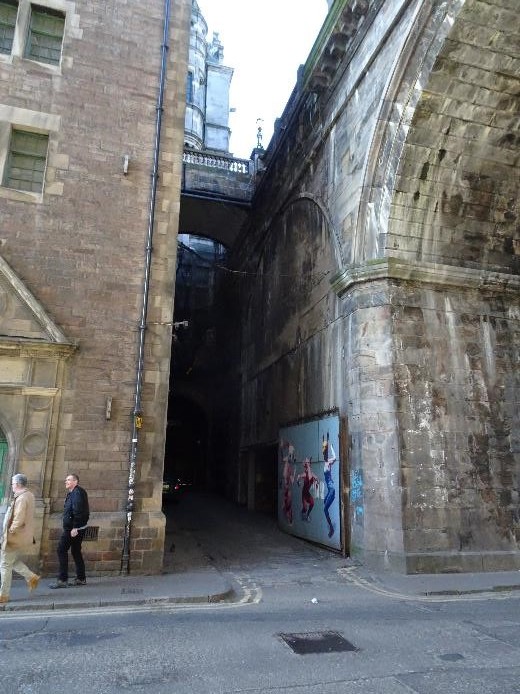A PDF version is available here.
I find Edinburgh endlessly fascinating. When I lived in Dundee it was a place for an excursion. From Exeter it is a rather harder journey, but I was there for a Future of Design Conference in April and took the chance to look again at the bridges over Cowgate, south of the old High Street.
Old Edinburgh sits on a glacial crag and tail. The very hard volcanic rock on which the castle stands has created an upstream (eastern) ramp as a narrow ridge and the High Street runs right down the ridge. Waverley station is now in the groove to the North and Cowgate to the South. I did some work on South Bridge back in the early 90s and that will (probably) feature next month. It has 17 spans. How many spans there really are in GeorgeIV I don’t know but it is, in any case, a very different bridge. The length of street which is given the name may be a clue.
Here is a view up the Cowgate towards Grassmarket. The buildings each side look perfectly normal where they face the street above and very tall from down here.
And here is the view down the slope.
I have been asked about photographing bridges for inspection records today so here is a point I made then. Much of this picture (left) is very dark and shows us nothing at all. However, even the very simple tools in Microsoft Word (go to \Format\Corrections and choose to the left of the examples offered). Provide a considerable level of enhancement (see below). We can now see more clearly that this is one span of a viaduct and there are at least two more spans to the North. Note the modest high level arch providing access to the first building and a much lower level one allowing this tiny side street to continue beneath.
But it is when you look up that things are particularly striking. It isn’t simply an arch but a cross vault. There are diagonal ribs springing from the chamfered corners of the pier with square spanning panels between.
The stone is very dark so seeing any features is also difficult at this range, and I didn’t have the freedom to seek out details and zoom in
Zooming the image rather than the camera shows that the camera was struggling with light levels. Pushing the centre of that image a little shows something slightly strange going on between the rib upper left in the picture and the panel above.
Looking from a different angle (below) the apparent cracks across stones in the top right rib (above) are clearer. It is also obvious that the rib stones and the web stones vary in thickness to match each other.
The photographs (rather more than shown here) were used to create the 3D model below. Click on the play button in the middle to load the model, then use the mouse to move it around. Go full screen (bottom right after loading) for best effect.
In the model, we can fly up close to the arch and see that the webs and ribs don’t fit together perfectly.
Screen capture from 3D model showing lack of fit between web and rib.
We can also get right up to the level of the crown and see that across the width of the Cowgate, the crown is roughly level, but along the length, both webs dip noticeably towards the centre. In sketchfab, the model surface can be viewed from front or back so this view is looking down on the skin of the stone. We are looking along the street here.
Turn the model through 90degrees and there is less to obstruct the view. Here the dip towards the centre is visible.
Do have a look at the model yourself and see how much extra can be extracted from a few minutes of photography.
The vault means there is a substantial opening north and south. I wonder whether that is to do with placating the original owners of the land?












